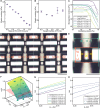3D printed anisotropic tissue simulants with embedded fluid capsules for medical simulation and training
- PMID: 40880468
- PMCID: PMC12396343
- DOI: 10.1126/sciadv.adw6446
3D printed anisotropic tissue simulants with embedded fluid capsules for medical simulation and training
Abstract
Human tissues are primarily composed of collagen and elastin fiber networks that exhibit directional mechanical properties that are not replicable by conventional tissue simulants manufactured via casting. Here, we 3D print tissue simulants that incorporate anisotropic mechanical properties through the manipulation of infill voxel shape and dimensions. A mathematical model for predicting the anisotropy of single- and multimaterial structures with orthogonal infill patterns is developed. We apply this methodology to generate conformal printing toolpaths for replicating the structure and directional mechanics observed in native tissue within 3D printed tissue simulants. Further, a method to embed fluid-filled capsules within the infill structure of these tissue simulants to mimic blood is also presented. The improvements in simulation quality when using 3D printed anisotropic tissue simulants over conventional tissue simulants are demonstrated via a comparative acceptability study. These advances open avenues for the manufacture of next-generation tissue simulants with high mechanical fidelity for enhanced medical simulation and training.
Figures




Similar articles
-
Prescription of Controlled Substances: Benefits and Risks.2025 Jul 6. In: StatPearls [Internet]. Treasure Island (FL): StatPearls Publishing; 2025 Jan–. 2025 Jul 6. In: StatPearls [Internet]. Treasure Island (FL): StatPearls Publishing; 2025 Jan–. PMID: 30726003 Free Books & Documents.
-
Innovative 3D-printed educational models for vital pulp treatments and local anesthesia training in pediatric dentistry.BMC Med Educ. 2025 Jul 28;25(1):1122. doi: 10.1186/s12909-025-07701-x. BMC Med Educ. 2025. PMID: 40721765 Free PMC article.
-
Development and Validation of a Hybrid Bronchoscopy Trainer Using Three-Dimensional Printing.Simul Healthc. 2024 Feb 1;19(1):52-55. doi: 10.1097/SIH.0000000000000687. Epub 2022 Sep 19. Simul Healthc. 2024. PMID: 36194854
-
Mechanical performance of 3-dimensionally printed resins compared with conventional and milled resins for the manufacture of occlusal devices: A systematic review.J Prosthet Dent. 2024 Dec;132(6):1262-1269. doi: 10.1016/j.prosdent.2022.12.006. Epub 2023 Jan 9. J Prosthet Dent. 2024. PMID: 36631367
-
Mechanical properties of 3D printed prosthetic materials compared with milled and conventional processing: A systematic review and meta-analysis of in vitro studies.J Prosthet Dent. 2024 Aug;132(2):381-391. doi: 10.1016/j.prosdent.2022.06.008. Epub 2022 Aug 5. J Prosthet Dent. 2024. PMID: 35934576
References
-
- Owen H., Early use of simulation in medical education. Simul. Healthc. 7, 102–116 (2012). - PubMed
-
- Maran N. J., Glavin R. J., Low- to high-fidelity simulation – A continuum of medical education. Med. Educ. 37 (Suppl. 1), 22–28 (2003). - PubMed
-
- Maglio S., Park C., Tognarelli S., Menciassi A., Roche E. T., High-fidelity physical organ simulators: From artificial to bio-hybrid solutions. IEEE Trans. Med. Robot. Bionics 3, 349–361 (2021).
-
- Mulyadi M., Tonapa S. I., Rompas S. S. J., Wang R.-H., Lee B.-O., Effects of simulation technology-based learning on nursing students’ learning outcomes: A systematic review and meta-analysis of experimental studies. Nurse Educ. Today 107, 105127 (2021). - PubMed
MeSH terms
LinkOut - more resources
Full Text Sources

